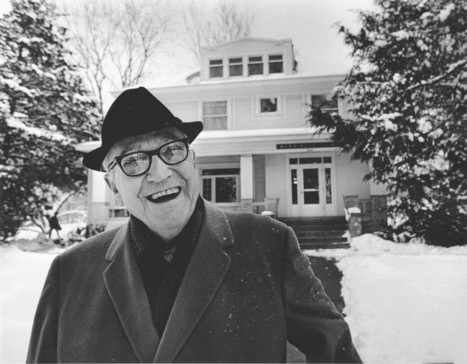Former Menninger's Clinic
Introduction
Text-to-speech Audio
This site was the original location of the Menninger Clinic until its move to Houston, Texas in June 2003. The Menninger family forever changed the face of psychiatry in the United States, and greatly influenced how mentally ill people are treated both in terms of societal standards and medical approach. So influential was the Menninger Clinic on broader society, that for a time there was even a billboard outside Topeka proclaiming the city as the “psychiatric capital of the world.” Though the clinic has since been moved to Houston, the original building still stands in Topeka, serving as a reminder of the work the Menninger family put in to change the way psychiatric treatment was viewed not just in the Midwest, but in the entire world.
Images
The Original Menninger Clinic Tower (1980)

Dr. William Menninger, Dr. Charles Menninger (father to William and Karl), and Dr. Karl Menninger (1930)

The new Menninger Clinic, located in Houston, Texas (2021)

Karl Menninger in front of the original Menninger Clinic, located in Topeka, KS (1970)

Backstory and Context
Text-to-speech Audio
In 1908, Dr. Charles Menninger, a physician, visited the Mayo Clinic and decided that he wanted to open a clinic focusing on physical health in Topeka. However, Karl Menninger, Charles’ son, had went to medical school at Harvard and studied psychiatry. In 1925, Charles and Karl bought a farmhouse in Topeka to begin an out-patient center. This was the beginning of what became known as the Menninger Clinic. Charles’ younger son, Will, also became a doctor and joined the clinic. The clinic later expanded into what is known as the Menninger Foundation, which included the Southard School, the Menninger School of Psychiatry, and The Will Menninger Center for Applied Behavioral Sciences. One out of eight psychiatric residents in the United States would study at the clinic by treating the hundreds of veterans and other patients that stayed there. Karl Menninger's vision of a psychiatric treatment facility was not only a research clinic, but one that would help people of all demographics.
The treatment at the Menninger Clinic was one of a kind. Patients could stay at the facility for extended periods of time, and social workers would do frequent checkups. Patients were not overlooked like they would be in other facilities at the time. The Menninger Clinic became popular before prescription drugs were accessible to patients, so one-on-one therapy was one of the most beneficial aspects of the clinic. The clinic promoted safe environments where people struggling with post-traumatic stress disorder could cope with the terror of war, without being put on medication against their will. In addition, people with cognitive disabilities were given opportunities to learn, rather than being subjected to ableist practices. Patients with physical disabilities were treated accordingly, and there were programs that were accommodating to their needs. There was a general physician who would treat all patients, but if patients needed more therapy, or requested more treatment, they would never be denied that treatment. Each patient was required to meet with a medical professional every day, and social workers were required to stay connected with the patient's family and make sure they had a safe environment to go home to.
The Menninger Clinic not only attracted people from all over the country, but all over the world as well. Its reputation for being people’s last hope for treatment even brought celebrities, such as former Green Bay Packers quarterback Brett Farve and actress Gene Tierney. There are also rumors of many other celebrities like Judy Garland, Nicole Kidman, Elizabeth Taylor, and Marilyn Monroe staying at the Menninger Clinic, but without access to the clinic’s patient records, it remains local gossip.
For the number of patients that the clinic received throughout the decades, Topeka was not as big of a city to host as many patients, nor was the clinic big enough to handle as many patients. Thus, the clinic was moved to Houston, Texas in 2003 to partner with Baylor University. The move was also largely due to the increase in the use of pharmaceuticals as treatment for mental illness. After the clinic moved, most of the buildings on the original campus property were demolished, with only a few remaining today. The Sunflower Foundation renovated the buildings that used to be the hospital, nursing dormitory, and power plant in 2019. The iconic clock tower, however, has sat abandoned since 2006, after vandals did $1 million in damage to the building. The building does have hope for a future though, after it was announced that a developer had been found who will renovate the property, meaning that the stark reminder of what was one the psychiatric capital of the world will remain standing.
Though Topeka does not truly acknowledge the impact the Menninger Foundation had on both its residents and society at large, the foundation donated money to promote mental and psychiatric treatment in Topeka. This came shortly after the foundation's decision to move the clinic to Houston, as the foundation still wanted residents of Topeka to have access to the treatment that they desire. Over 80 million dollars in the foundation's assets remain in Kansas.
Sources
Associated Press. “Brett Favre Says He Went to Rehab 3 Times to Fight Addictions, Including a Stint in Topeka.” The Topeka Capital-Journal. Topeka Capital-Journal, May 22, 2018. https://www.cjonline.com/story/news/2018/05/22/brett-favre-says-he-went-to-rehab-3-times-to-fight-addictions-including-stint-in-topeka/12163181007/.
Associated Press. “Vandals Damage Menninger Tower.” LJWorld.com, July 5, 2006. https://www2.ljworld.com/news/2006/jul/05/vandals_damage_menninger_tower/.
Donahue, Kimberly. “Abandoned KS Team: Developer Found to Take Ownership of Menninger Clock Tower.” WIBW, December 10, 2021. https://www.wibw.com/2021/12/10/abandoned-ks-team-developer-found-take-ownership-menninger-clock-tower/.
Friedman, Lawrence, J. “Menninger: The Family and the Clinic” University Press of Kansas, (1992). At the time this book was published, Friedman was the only historian who had full access to the Menninger archives.
Goode, Erica. “Famed Psychiatric Clinic ABANDONS Prairie Home.” The New York Times. The New York Times, May 31, 2003. https://www.nytimes.com/2003/05/31/us/famed-psychiatric-clinic-abandons-prairie-home.html?.%3Fmc=aud_dev&ad-keywords=auddevgate&gclid=EAIaIQobChMIg_XYkOug8wIVjYnICh3lqQCJEAMYASAAEgJM_vD_BwE&gclsrc=aw.ds.
Grossman, Ron. “Era Ends for Menningers.” Chicago Tribune, August 28, 2018. https://www.chicagotribune.com/news/ct-xpm-2001-07-03-0107030172-story.html.
Hrenchir, Tim. “History Guy: Topekan Menninger Changed How Society Views the Mentally Ill.” The Topeka Capital-Journal. Topeka Capital-Journal, July 22, 2020. https://www.cjonline.com/story/news/local/2020/07/22/history-guy-topekan-menninger-changed-how-society-views-mentally-ill/43104379/.
Kansas Historical Society. “Menninger Clinic.” Kansas Historical Society, December 2004. https://www.kshs.org/kansapedia/menninger-clinic/12147.
“Karl Menninger, 96, Dies; Leader in U.S. Psychiatry.” The New York Times. The New York Times, July 19, 1990. https://www.nytimes.com/1990/07/19/obituaries/karl-menninger-96-dies-leader-in-us-psychiatry.html.
Kniggendorf, Anne. “Time Running Out for Iconic Menninger Clock Tower in Topeka; Demolition Permit under Review.” Kansas Public Radio, February 1, 2021. https://kansaspublicradio.org/kpr-news/time-running-out-iconic-menninger-clock-tower-topeka-demolition-permit-under-review.
McKelvey, John. “The Tangled Trail from Topeka to Houston: The Menninger Clinic-Mid-1999 to Mid-2003: A Personal Recollection.” Bulletin of the Menninger Clinic, vol. 75, no. 2, Spring 2011, pp. 119–125. EBSCOhost, doi:10.1521/bumc.2011.75.2.119. McKelvey was on the board for the Menninger Clinic at the time of the relocation in 2003.
Menninger, Roy W. “The Therapeutic Environment and Team Approach at the Menninger Hospital.” Psychiatry and Clinical Neurosciences, 52: S173-S176 (1998). https://doi.org/https://doi.org/10.1111/j.1440-1819.1998.tb03214.x.
Miles, David. “Menninger Clinic Moving to Texas.” AP NEWS. Associated Press, September 28, 2000. https://apnews.com/afe787f8b403b7c24d3ec26627237fe9.
Romano, Michael. “Lasting Legacy” Modern Healthcare, vol 33, no 20, May 2003, p. 16
EBSCOhost, search.ebscohost.com/login.aspdirect=true&db=a9h&AN=9864784&site=e host-live.
Schlesinger, Herbert J. “The Treatment Program at Menninger.” American Imago, vol. 64, no. 2, The Johns Hopkins University Press, 2007, 229-40 http://www.jstor/stable/26305302.
Topeka History Geeks. “Anyone Know Anything about the Actress Gene Tierney's Having Mental Problems, Undergoing Shock Therapy, Being Talked off a 14 Story Balcony, and Spending Considerable Time at Our Menninger Clinic in 1957?” Facebook, 2020. https://www.facebook.com/groups/TopekaHistoryGeeks/posts/3043421345703008/?comment_id=3886656311379503.
Wallerstein, Robert S. "Karl A. Menninger, M.D.: A Personal Perspective." American Imago 64, no. 2 (2007): 213-28.
Wallerstein, Robert. S. “Karl Menninger and Arthur Marshall: Comments on the early years of the Menninger School of Psychiatry. Psychohistory Review, (1990). 123 – 135. Wallerstein was a friend of Dr. Karl Menninger, and much of his work was devoted towards researching and discussing the Menninger Clinic
Willetts, Alyssa. “Menninger Hill Renovations Set to Be Complete in August.” WIBW, January 3, 2020. https://www.wibw.com/content/news/Menninger-Hill-renovations-set-to-be-complete-in-August-566703681.html.
Kansas Attorney General
Kansas Historical Society
Psychology Today
Kansas Historical Society
